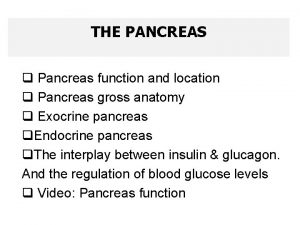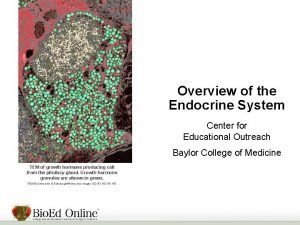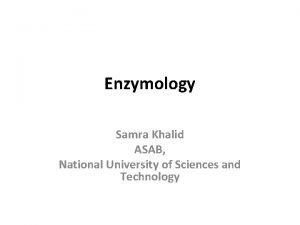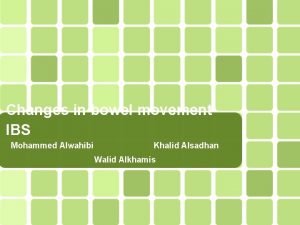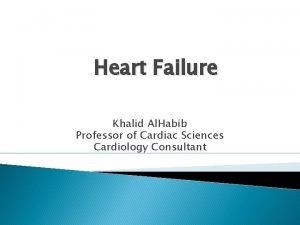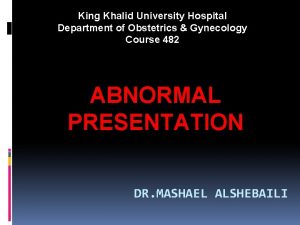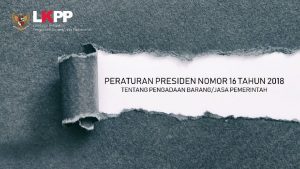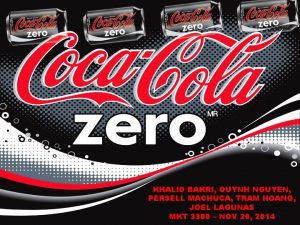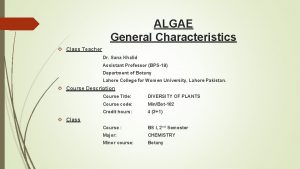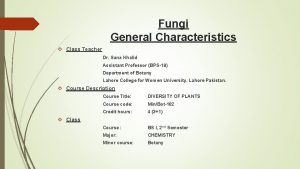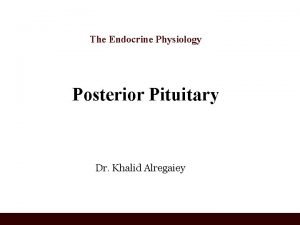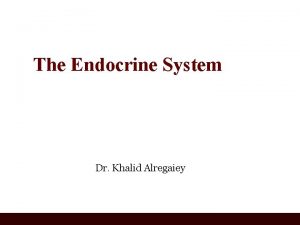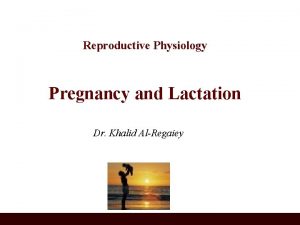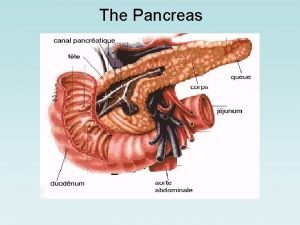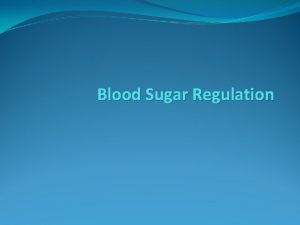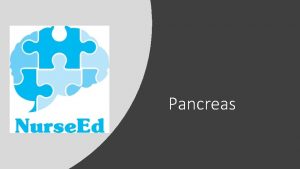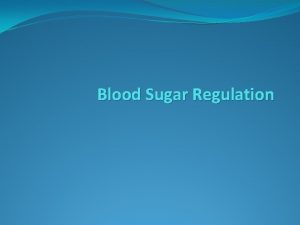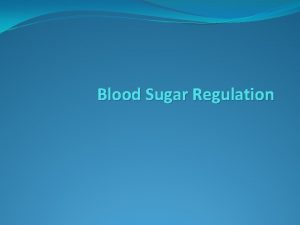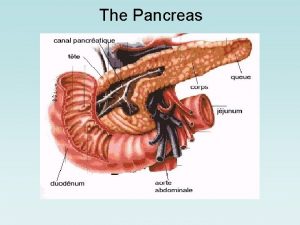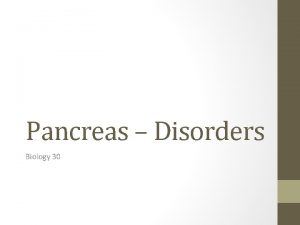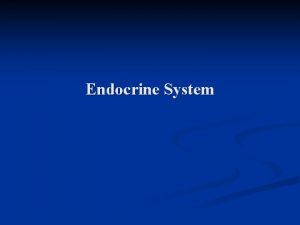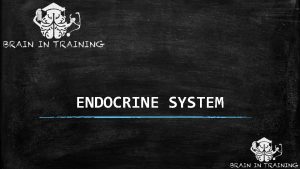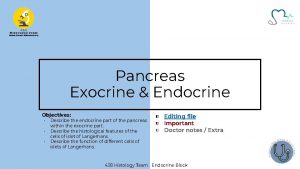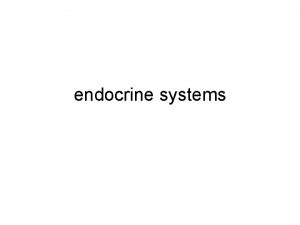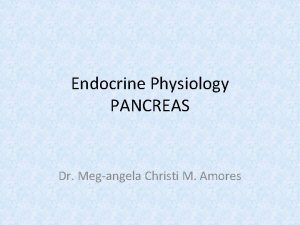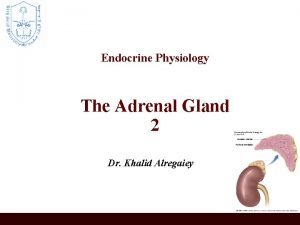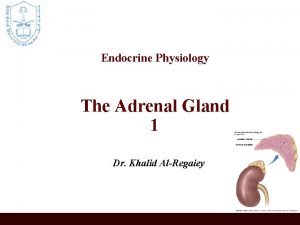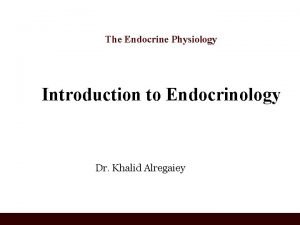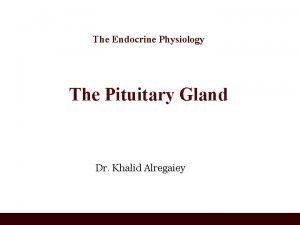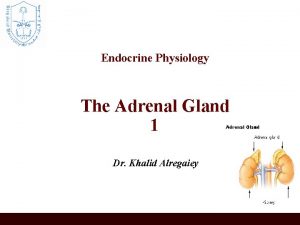Endocrine Physiology The Endocrine Pancreas Dr Khalid AlRegaiey













































- Slides: 45

Endocrine Physiology The Endocrine Pancreas Dr. Khalid Al-Regaiey

Pancreas • A triangular gland, which has both exocrine and endocrine cells, located behind the stomach • Strategic location • Acinar cells produce an enzyme-rich juice used for digestion (exocrine product) • Pancreatic islets (islets of Langerhans) produce hormones involved in regulating fuel storage and use.

The Endocrine Pancreas

Islets of Langerhans • 1 -2 million islets • Beta (β) cells produce insulin (70%) • Alpha (α) cells produce glucagon (20%) • Delta (δ) cells produce somatostatin (5%) • F cells produce pancreatic polypeptide (5%)

Islets of Langerhans

Insulin • Hormone of nutrient abundance • A protein hormone consisting of two amino acid chains linked by disulfide bonds • Synthesized as part of proinsulin (86 AA) and then excised by enzymes, releasing functional insulin (51 AA) and C peptide (29 AA). • Has a plasma half-life of 6 minutes.

Insulin Structure

Insulin Synthesis DNA (chromosome 11) in β cells m. RNA Preproinsulin (signal peptide, A chain, B chain, and peptide C) proinsulin

Insulin Synthesis • Insulin synthesis is stimulated by glucose or feeding and decreased by fasting • Threshold of glucose-stimulated insulin secretion is 100 mg/dl. • Glucose rapidly increase the translation of the insulin m. RNA and slowly increases transcription of the insulin gene

Glucose is the primary stimulator of insulin secretion



Blood Gastrointestinal hormones Food intake Parasympathetic stimulation glucose concentration Major control Islet cells Insulin secretion Factors controlling insulin secretion Blood glucose Blood fatty acids Blood amino acid Protein synthesis Fuel storage Blood amino acid conc. Sympathetic stimulation (and epinephrine)

Regulation of Insulin Secretion

Insulin Receptor • the insulin receptor is a transmembrane receptor • belongs to the large class of tyrosine kinase receptors • Made of two alpha subunits and two beta subunits


Actions of insulin

• Raapid (seconds) • (+) transport of glucose, amino acids, K+ into insulin-sensitive cells • Intermediate (minutes) • (+) protein synthesis • (-) protein degradation • (+) of glycolytic enzymes and glycogen synthase • (-) phosphorylase and gluconeogenic enzymes • Delayed (hours) • (+) m. RNAs for lipogenic and other enzymes

Action of insulin on Adipose tissue • (+) glucose entry • (+) fatty acid synthesis • (+) glycerol phosohate synthesis • (+) triglyceride dep 0 sition • (+)lipoprotein lipase • (-) of hormone-sensitive lipase • (+) K uptake

Action of insulin on Muscle: • (+) glucose entry • (+) glycogen synthesis • (+) amino acid uptake • (+) protein synthesis in ribosomes • (-) protein catabolism • (-) release of gluconeogenic aminco acids • (+) ketone uptake • (+) K uptake

Action of insulin on Liver: • (-) ketogenesis • (+) protein synthesis • (+) lipid synthesis • (-)gluconogenesis, (+) glycogen synthesis, (+) glycolysis.

General • (+) cell growth

Glucose Transport • GLUT 1 (erythrocytes, brain) • GLUT 2 (liver, pancreas, small intestines, kidney) • GLUT 3 (brain) • GLUT 4, insulin sensitive transporter (muscle, adipose tissue)

Insulin: Summary


Glucagon • A 29 -amino-acid polypeptide hormone that is a potent hyperglycemic agent • Produced by α cells in the pancreas

SYNTHESIS DNA in α cells (chromosome 2) m. RNA Preproglucagon

Factors Affecting Glucagon Secretion:

Glucagon Actions • Its major target is liver: • Glycogenolysis • Gluconeogenesis • Lipid oxidation (fully to CO 2 or partially to produce keto acids “ketone bodies”). • Release of glucose to the blood from liver cells

Glucagon Action on Cells:


The Regulation of Blood Glucose Concentrations

Diabetes • Diabetes is probably the most important metabolic disease. • It affects every cell in the body and affects carbohydrate, lipid, and protein metabolism. • characterized by the polytriad: • Polyuria (excessive urination) • Polydypsia (excessive thirst) • Polyphagia (excessive hunger).

Types of Diabetes Type 1 Diabetes Type 2 diabetes Affects children Affects adults Cause: Cause defect in inadequate insulin secretion Treatment : insulin injection insulin action Treatment : diet or OHA

Inadequate secretion of insulin Cause Defects in the action of insulin Metabolic disturbances (hyperglycemia and glycosuria)

Type 1 diabetes

Diabetes Mellitus Type I • Caused by an immune-mediated selective destruction of β cells • β cells are destroyed while α cells are preserved: No insulin : : high glucagon of glucose and ketones by liver glucose & ketones keto acids high production osmotic diuresis diabetic ketoacidosis

Diabetes Mellitus: Type II • More common in some ethnic groups • Insulin resistance keeps blood glucose too high • Chronic complications: atherosclerosis, renal failure & blindness


Glucose Tolerance Test • Both the FPG and OGTT tests require that the patient fast for at least 8 hours (ideally 12 hr) prior to the test. • The oral glucose tolerance test (OGTT): • FPG test • Blood is then taken 2 hours after drinking a special glucose solution

Glucose Tolerance Test (GTT) • Following the oral administration of a standard dose of glucose, the plasma glucose concentration normally rises but returns to the fasting level within 2 hours. • If insulin activity is reduced, the plasma glucose concentration takes longer than 2 hours to return to normal and often rises above 200 mg/dl. • Measurement of urine glucose allows determination of the renal threshold for glucose.

GTT

Glucose Tolerance Testsuggest different conditions: • The following results • Normal values: • FPG <100 mg/dl • 2 hr PPG < 140 mg/d. L • Impaired glucose tolerance • 2 hr PPG = 140 - 199 mg/d. L • Impaired fasting glucose • FPG=100 -125 • Diabetes • FPG ≥ 126 mg/dl • 2 hr PPG levels ≥ 200 mg/d. L

Symptoms of Diabetes Mellitus

Diabetes Mellitus (DM)
 Endocrine pancreas histology
Endocrine pancreas histology Vascolarizzazione pancreas
Vascolarizzazione pancreas Pancreas in endocrine system
Pancreas in endocrine system Anatomy and physiology of diabetes
Anatomy and physiology of diabetes Pancreas anatomy and physiology
Pancreas anatomy and physiology Dr samra khalid
Dr samra khalid Khalid karaoui
Khalid karaoui Dr khalid waheed
Dr khalid waheed Khalid alsadhan
Khalid alsadhan Khalid al habib
Khalid al habib Brow presentation birth
Brow presentation birth Cipralex side effects
Cipralex side effects Khalid mustafa
Khalid mustafa Welcome to english class
Welcome to english class Khalid bazaid
Khalid bazaid Khalid bakri
Khalid bakri Nauman khalid md
Nauman khalid md Dr sarah cox
Dr sarah cox Sana khalid
Sana khalid Yitzhak rabin
Yitzhak rabin Khalid nationality
Khalid nationality Khalid al dossary
Khalid al dossary Complete the tag question your name is ali khalid
Complete the tag question your name is ali khalid Fariza khalid
Fariza khalid Dr sana khalid
Dr sana khalid Dr khalid jamal
Dr khalid jamal Dr fariza khalid
Dr fariza khalid Khalid farhan course google drive
Khalid farhan course google drive Khalid chaouch
Khalid chaouch Hình ảnh bộ gõ cơ thể búng tay
Hình ảnh bộ gõ cơ thể búng tay Tỉ lệ cơ thể trẻ em
Tỉ lệ cơ thể trẻ em Thế nào là mạng điện lắp đặt kiểu nổi
Thế nào là mạng điện lắp đặt kiểu nổi Lời thề hippocrates
Lời thề hippocrates Vẽ hình chiếu đứng bằng cạnh của vật thể
Vẽ hình chiếu đứng bằng cạnh của vật thể Quá trình desamine hóa có thể tạo ra
Quá trình desamine hóa có thể tạo ra Phản ứng thế ankan
Phản ứng thế ankan Môn thể thao bắt đầu bằng từ đua
Môn thể thao bắt đầu bằng từ đua Khi nào hổ mẹ dạy hổ con săn mồi
Khi nào hổ mẹ dạy hổ con săn mồi Các loại đột biến cấu trúc nhiễm sắc thể
Các loại đột biến cấu trúc nhiễm sắc thể điện thế nghỉ
điện thế nghỉ Biện pháp chống mỏi cơ
Biện pháp chống mỏi cơ Trời xanh đây là của chúng ta thể thơ
Trời xanh đây là của chúng ta thể thơ Voi kéo gỗ như thế nào
Voi kéo gỗ như thế nào Thiếu nhi thế giới liên hoan
Thiếu nhi thế giới liên hoan Phối cảnh
Phối cảnh Các châu lục và đại dương trên thế giới
Các châu lục và đại dương trên thế giới

